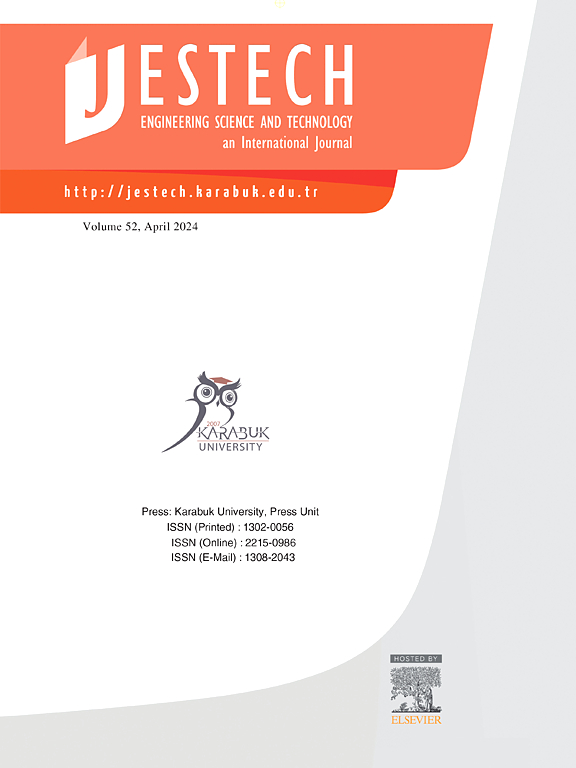A novel sub-windowing local binary pattern approach for dorsal finger creases based biometric classification system
IF 5.1
2区 工程技术
Q1 ENGINEERING, MULTIDISCIPLINARY
Engineering Science and Technology-An International Journal-Jestech
Pub Date : 2024-11-11
DOI:10.1016/j.jestch.2024.101882
引用次数: 0
Abstract
Biometric authentication systems have been widely deployed in various applications, including security systems, bank transactions and authentication on smart electronic devices. Obtaining the salient and distinctive features is very important for achieving high accuracy in biometric authentication systems. Local binary pattern (LBP) variants are the best-performing local descriptors and are popular due to computational simplicity and flexibility. However, most of the existing LBP variants consider a 3 × 3 window with one specific central pixel for all neighborhoods, which affects the sensitivity to non-monotonic intensity changes and reduces the robustness of the feature description. Thus, a new variant of LBP called TD-LBP is introduced, which is based on the four T-shape sub-windows and two diagonal (D) regions. Inspired by the sub-windowing approach to capture the microstructure information of the image, TD-LBP first divides the 3 × 3-pixel window into four sub-regions of T-shape structure and then takes two diagonal regions to extract more texture information. Three different classifiers, artificial neural network (ANN), support vector machine (SVM), and k-nearest neighbor (KNN) are employed to evaluate the effectiveness of the proposed approach for dorsal finger crease biometric system. Experiments conducted on the self-collected dorsal finger crease dataset demonstrate the prominent performance and suitability of the proposed TD-LBP for a newly explored finger crease biometric identifier. The proposed approach was able to achieve 96.67 %, 89.26 %, and 82.22 % classification accuracies for ANN, SVM, and KNN classifiers, respectively. Moreover, we clearly validate the viability of the proposed TD-LBP descriptor for the dorsal finger crease biometric trait by comparing the results with state-of-the-art biometric system based LBP descriptors. The significance of the TD-LBP method is demonstrated with improved verification and identification results through receiver operating characteristic (ROC) and cumulative match characteristic (CMC) curves respectively.
基于指背褶皱的生物识别分类系统的新型子窗口局部二进制模式方法
生物识别认证系统已广泛应用于各种领域,包括安全系统、银行交易和智能电子设备认证。要想在生物识别认证系统中实现高准确率,获得突出的特征是非常重要的。局部二进制模式(LBP)变体是性能最好的局部描述符,因其计算简单和灵活性而广受欢迎。然而,大多数现有的局部二值模式变体都考虑了一个 3 × 3 窗口,所有邻域都有一个特定的中心像素,这影响了对非单调强度变化的敏感性,降低了特征描述的鲁棒性。因此,我们引入了一种名为 TD-LBP 的新 LBP 变体,它基于四个 T 形子窗口和两个对角线 (D) 区域。受子窗口捕捉图像微观结构信息方法的启发,TD-LBP 首先将 3 × 3 像素的窗口划分为四个 T 形结构的子区域,然后提取两个对角线区域以提取更多纹理信息。该系统采用了人工神经网络(ANN)、支持向量机(SVM)和 k-nearest neighbor(KNN)三种不同的分类器来评估所提出的方法在指背折痕生物识别系统中的有效性。在自收集的手指背侧折痕数据集上进行的实验证明了所提出的 TD-LBP 在新探索的手指折痕生物识别系统中的突出性能和适用性。对于 ANN、SVM 和 KNN 分类器,所提出的方法分别达到了 96.67%、89.26% 和 82.22% 的分类准确率。此外,通过与基于 LBP 描述符的最先进生物识别系统的结果进行比较,我们清楚地验证了所提出的 TD-LBP 描述符在指背皱褶生物识别特征方面的可行性。通过接收器操作特征曲线(ROC)和累积匹配特征曲线(CMC),TD-LBP 方法的验证和识别结果都得到了改善,从而证明了该方法的重要性。
本文章由计算机程序翻译,如有差异,请以英文原文为准。
求助全文
约1分钟内获得全文
求助全文
来源期刊

Engineering Science and Technology-An International Journal-Jestech
Materials Science-Electronic, Optical and Magnetic Materials
CiteScore
11.20
自引率
3.50%
发文量
153
审稿时长
22 days
期刊介绍:
Engineering Science and Technology, an International Journal (JESTECH) (formerly Technology), a peer-reviewed quarterly engineering journal, publishes both theoretical and experimental high quality papers of permanent interest, not previously published in journals, in the field of engineering and applied science which aims to promote the theory and practice of technology and engineering. In addition to peer-reviewed original research papers, the Editorial Board welcomes original research reports, state-of-the-art reviews and communications in the broadly defined field of engineering science and technology.
The scope of JESTECH includes a wide spectrum of subjects including:
-Electrical/Electronics and Computer Engineering (Biomedical Engineering and Instrumentation; Coding, Cryptography, and Information Protection; Communications, Networks, Mobile Computing and Distributed Systems; Compilers and Operating Systems; Computer Architecture, Parallel Processing, and Dependability; Computer Vision and Robotics; Control Theory; Electromagnetic Waves, Microwave Techniques and Antennas; Embedded Systems; Integrated Circuits, VLSI Design, Testing, and CAD; Microelectromechanical Systems; Microelectronics, and Electronic Devices and Circuits; Power, Energy and Energy Conversion Systems; Signal, Image, and Speech Processing)
-Mechanical and Civil Engineering (Automotive Technologies; Biomechanics; Construction Materials; Design and Manufacturing; Dynamics and Control; Energy Generation, Utilization, Conversion, and Storage; Fluid Mechanics and Hydraulics; Heat and Mass Transfer; Micro-Nano Sciences; Renewable and Sustainable Energy Technologies; Robotics and Mechatronics; Solid Mechanics and Structure; Thermal Sciences)
-Metallurgical and Materials Engineering (Advanced Materials Science; Biomaterials; Ceramic and Inorgnanic Materials; Electronic-Magnetic Materials; Energy and Environment; Materials Characterizastion; Metallurgy; Polymers and Nanocomposites)
 求助内容:
求助内容: 应助结果提醒方式:
应助结果提醒方式:


